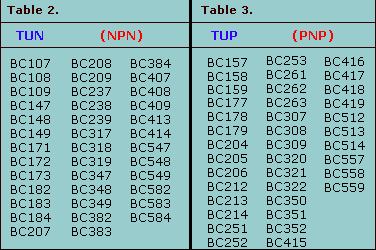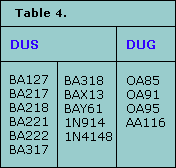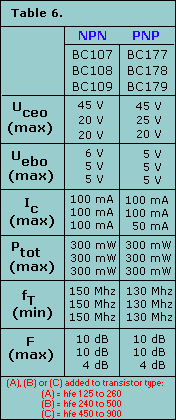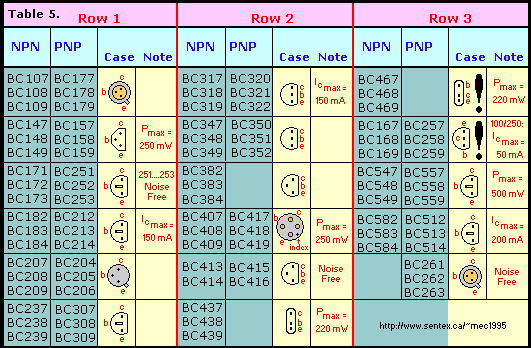
Circuits, as published and used by Elektor and the Dutch Elektuur, contain universal
transistors and diodes to the abbreviations: TUP (Transistor Universal Pnp), TUN (Transistor Universal Npn), DUS
(Diode Universal Silicon), and DUG (Diode Universal Germanium). Many transistors and diodes fit this way in these
categories and makes component selection easier. Good system!
 The minumum specifications have to be met,
in Table 1a above, before you can call it a
'TUP' or a 'TUN'.
The minumum specifications have to be met,
in Table 1a above, before you can call it a
'TUP' or a 'TUN'.
 The minumum specifications have to be met, in
Table 1b above, before you can call it a 'DUS'
or a 'DUG'.
The minumum specifications have to be met, in
Table 1b above, before you can call it a 'DUS'
or a 'DUG'.
 In the above tables, Table 2 & 3, you
can use several different transistor types for a
TUP or a TUN. Obviously the tables are not
complete. It would be almost impossible to list
all available transistor types available today.
From the above listed types are all A, B, or C
types usable.
In the above tables, Table 2 & 3, you
can use several different transistor types for a
TUP or a TUN. Obviously the tables are not
complete. It would be almost impossible to list
all available transistor types available today.
From the above listed types are all A, B, or C
types usable.
 Several different types of diodes are suitable
as a 'DUS' or 'DUG'.
Several different types of diodes are suitable
as a 'DUS' or 'DUG'.
 The most important parameters of the BC107...BC109
and the BC177...BC179. These transistors have been
choosen as an example of information.
The most important parameters of the BC107...BC109
and the BC177...BC179. These transistors have been
choosen as an example of information.

The letter after the transistor indicates the hfe.
Example: BC107A, hfe = 125 ... 260
BC107B, hfe = 240 ... 500
BC107C, hfe = 450 ... 900
Substitutes within the BC series of transistors are also possible.
In Table 6 you see that the transisors are grouped in three. Example, the
BC107, BC147, BC317 and BC413 can be substituted with each other, but a BC548
may not be exchanged for a BC107. Why? The BC548 is the second of a group
of three. Your choice would be a BC547(A,B, or C).
Back to Circuits or Gadgets Page
Copyright © 1996 - by Tony van Roon, VA3AVR


The minumum specifications have to be met, in Table 1a above, before you can call it a 'TUP' or a 'TUN'.
The minumum specifications have to be met, in Table 1b above, before you can call it a 'DUS' or a 'DUG'.
In the above tables, Table 2 & 3, you can use several different transistor types for a TUP or a TUN. Obviously the tables are not complete. It would be almost impossible to list all available transistor types available today. From the above listed types are all A, B, or C types usable.
Several different types of diodes are suitable as a 'DUS' or 'DUG'.
The most important parameters of the BC107...BC109 and the BC177...BC179. These transistors have been choosen as an example of information.
